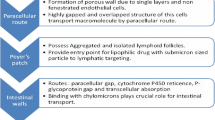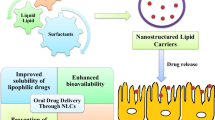Abstract
Purpose
Lipid-based formulations (LBF) have shown oral bioavailability enhancement of lipophilic drugs, but not necessarily in the case of hydrophobic drugs. This study explored the potential of lipid vehicles to improve the bioavailability of the hydrophobic drug nilotinib comparing a chase dosing approach and lipid suspensions.
Methods
Nilotinib in vivo bioavailability in rats was determined after administering an aqueous suspension chase dosed with blank olive oil, Captex 1000, Peceol or Capmul MCM, respectively. Absolute bioavailability was determined (relative to an intravenous formulation). Pharmacokinetic parameters were compared to lipid suspensions.
Results
Compared to the lipid suspensions, the chase dosed lipids showed a 2- to 7-fold higher bioavailability. Both long chain chase dosed excipients also significantly increased the bioavailability up to 2-fold compared to the aqueous suspension. Deconvolution of the pharmacokinetic data indicated that chase dosing of nilotinib resulted in prolonged absorption compared to the aqueous suspension.
Conclusion
Chase dosed LBF enhanced the in vivo bioavailability of nilotinib. Long chain lipids showed superior performance compared to medium chain lipids. Chase dosing appeared to prolong the absorption phase of the drug. Therefore, chase dosing of LBF is favourable compared to lipid suspensions for ‘brick dust’ molecules such as nilotinib.

The potential of bio-enabling lipid vehicles, administered via chase dosing and lipid suspensions, has been evaluated as an approach to enhance oral bioavailability of nilotinib.




Similar content being viewed by others
Abbreviations
- MC:
-
Medium chain
- LC:
-
Long chain
- MG:
-
Monoglyceride
- TG:
-
Triglyceride
- LBF:
-
Lipid-based formulation
References
Savla R, Browne J, Plassat V, Wasan KM, Wasan EK. Review and analysis of FDA approved drugs using lipid-based formulations. Drug Dev Ind Pharm. 2017:1–16.
Feeney OM, Crum MF, McEvoy CL, Trevaskis NL, Williams HD, Pouton CW, et al. 50years of oral lipid-based formulations: provenance, progress and future perspectives. Adv Drug Deliv Rev. 2016;101:167–94.
O’Driscoll CM, Griffin BT. Biopharmaceutical challenges associated with drugs with low aqueous solubility--the potential impact of lipid-based formulations. Adv Drug Deliv Rev. 2008;60(6):617–24.
Humberstone AJ, Charman WN. Lipid-based vehicles for the oral delivery of poorly water soluble drugs. Adv Drug Deliver Rev. 1997;25(1):103–28.
Alskar LC, Porter CJ, Bergstrom CA. Tools for early prediction of drug loading in lipid-based formulations. Mol Pharm. 2016;13(1):251–61.
Morgen M, Saxena A, Chen XQ, Miller W, Nkansah R, Goodwin A, et al. Lipophilic salts of poorly soluble compounds to enable high-dose lipidic SEDDS formulations in drug discovery. Eur J Pharm Biopharm. 2017;117:212–23.
Sahbaz Y, Williams HD, Nguyen TH, Saunders J, Ford L, Charman SA, et al. Transformation of poorly water-soluble drugs into lipophilic ionic liquids enhances oral drug exposure from lipid based formulations. Mol Pharm. 2015;12(6):1980–91.
Larsen A, Holm R, Pedersen ML, Mullertz A. Lipid-based formulations for Danazol containing a digestible surfactant, Labrafil M2125CS: in vivo bioavailability and dynamic in vitro lipolysis. Pharm Res-Dordr. 2008;25(12):2769–77.
Dahan A, Hoffman A. The effect of different lipid based formulations on the oral absorption of lipophilic drugs: the ability of in vitro lipolysis and consecutive ex vivo intestinal permeability data to predict in vivo bioavailability in rats. Eur J Pharm Biopharm. 2007;67(1):96–105.
Larsen AT, Holm R, Mullertz A. Solution or suspension - does it matter for lipid based systems? In vivo studies of chase dosing lipid vehicles with aqueous suspensions of a poorly soluble drug. Eur J Pharm Biopharm. 2017;117:308–14.
Christiansen ML, Holm R, Abrahamsson B, Jacobsen J, Kristensen J, Andersen JR, et al. Effect of food intake and co-administration of placebo self-nanoemulsifying drug delivery systems on the absorption of cinnarizine in healthy human volunteers. Eur J Pharm Sci. 2016;84:77–82.
Thomas N, Richter K, Pedersen TB, Holm R, Mullertz A, Rades T. In vitro lipolysis data does not adequately predict the in vivo performance of lipid-based drug delivery systems containing fenofibrate. AAPS J. 2014;16(3):539–49.
Carrigan PJ, Bates TR. Biopharmaceutics of drugs administered in lipid-containing dosage forms .1. Gi-Absorption of griseofulvin from an oil-in-water emulsion in rat. J Pharm Sci-Us. 1973;62(9):1476–9.
Koehl NJ, Holm R, Kuentz M, Griffin BT. New insights into using lipid based suspensions for "brick dust' molecules: case study of nilotinib. Pharm Res-Dordr. 2019;36(4).
Rolan PE, Mercer AJ, Weatherley BC, Holdich T, Meire H, Peck RW, et al. Examination of some factors responsible for a food-induced increase in absorption of atovaquone. Br J Clin Pharmacol. 1994;37(1):13–20.
Alskar LC, Parrow A, Keemink J, Johansson P, Abrahamsson B, Bergstrom CAS. Effect of lipids on absorption of carvedilol in dogs: is coadministration of lipids as efficient as a lipid-based formulation? J Control Release. 2019;304:90–100.
ICH Guideline. Validation of analytical procedures: text and methodology Q2 (R1). In.International conference on harmonization, Geneva, Switzerland: ICH harmonised tripartite guideline; 2005.
Langenbucher F, Mysicka J. Invitro and invivo deconvolution assessment of drug release kinetics from oxprenolol oros preparations. Brit J Clin Pharmaco. 1985;19:S151–62.
Henze LJ, Griffin BT, Christiansen M, Bundgaard C, Langguth P, Holm R. Exploring gastric emptying rate in minipigs: effect of food type and pre-dosing of metoclopramide. Eur J Pharm Sci. 2018;118:183–90.
McLaughlin J, Lucà MG, Jones MN, D'Amato M, Dockray GJ, Thompson DG. Fatty acid chain length determines cholecystokinin secretion and effect on human gastric motility. Gastroenterology. 1999;116(1):46–53.
McLaughlin JT, Lomax RB, Hall L, Dockray GJ, Thompson DG, Warhurst G. Fatty acids stimulate cholecystokinin secretion via an acyl chain length-specific, Ca2+−dependent mechanism in the enteroendocrine cell line STC-1. J Physiol. 1998;513(Pt 1):11–8.
Porter CJH, Trevaskis NL, Charman WN. Lipids and lipid-based formulations: optimizing the oral delivery of lipophilic drugs. Nat Rev Drug Discov. 2007;6(3):231–48.
Pouton CW. Formulation of poorly water-soluble drugs for oral administration: physicochemical and physiological issues and the lipid formulation classification system. Eur J Pharm Sci. 2006;29(3–4):278–87.
Ditzinger F, Price DJ, Ilie AR, Kohl NJ, Jankovic S, Tsakiridou G, Aleandri S, Kalantzi L, Holm R, Nair A, Saal C, Griffin B, Kuentz M. Lipophilicity and hydrophobicity considerations in bio-enabling oral formulations approaches - a PEARRL review. J Pharm Pharmacol. 2018.
Thomas N, Holm R, Garmer M, Karlsson JJ, Mullertz A, Rades T. Supersaturated self-nanoemulsifying drug delivery systems (super-SNEDDS) enhance the bioavailability of the poorly water-soluble drug simvastatin in dogs. AAPS J. 2013;15(1):219–27.
Thomas N, Holm R, Mullertz A, Rades T. In vitro and in vivo performance of novel supersaturated self-nanoemulsifying drug delivery systems (super-SNEDDS). J Control Release. 2012;160(1):25–32.
FDA. Nilotinib (Tasigna) - Clinical Pharmacology and Biopharmaceutics Review. U.S. Department of Health and Human Services. 2018 October 01. Available from: https://www.accessdata.fda.gov/drugsatfda_docs/nda/2007/022068toc.cfm
Kaukonen AM, Boyd BJ, Charman WN, Porter CJH. Drug solubilization behavior during in vitro digestion of suspension formulations of poorly water-soluble drugs in triglyceride lipids. Pharm Res-Dordr. 2004;21(2):254–60.
Feinle C, Grundy D, Fried M. Modulation of gastric distension-induced sensations by small intestinal receptors. Am J Physiol Gastrointest Liver Physiol. 2001;280(1):G51–7.
Qualls-Creekmore E, Tong M, Holmes GM. Gastric emptying of enterally administered liquid meal in conscious rats and during sustained anaesthesia. Neurogastroenterol Motil. 2010;22(2):181–5.
O'Shea JP, Holm R, O'Driscoll CM, Griffin BT. Food for thought: formulating away the food effect - a PEARRL review. J Pharm Pharmacol. 2018.
ACKNOWLEDGMENTS AND DISCLOSURES
This work was kindly supported by funding from the Horizon 2020 Marie Sklodowska-Curie Innovative Training Networks programme under grant agreement No. 674909. The authors are part of the PEARRL European Training network, which is funded under this MSCA programme.
Author information
Authors and Affiliations
Corresponding author
Additional information
Publisher’s Note
Springer Nature remains neutral with regard to jurisdictional claims in published maps and institutional affiliations.
Rights and permissions
About this article
Cite this article
Koehl, N.J., Holm, R., Kuentz, M. et al. Chase Dosing of Lipid Formulations to Enhance Oral Bioavailability of Nilotinib in Rats. Pharm Res 37, 124 (2020). https://doi.org/10.1007/s11095-020-02841-9
Received:
Accepted:
Published:
DOI: https://doi.org/10.1007/s11095-020-02841-9




